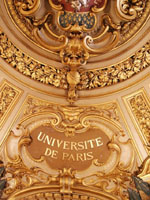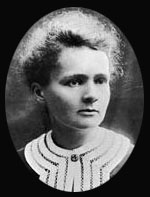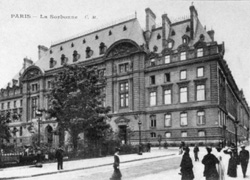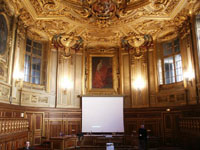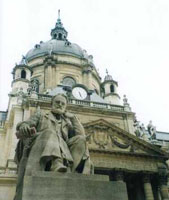|
For my second major project in the Wonderful World of Discovery Learning, I decided that I'd like to return to the Sorbonne at about the Eighteen-Nineties.
My goal is to get a reading on the differences between a college student from the Sorbonne of the late nineteenth century and my current situation at UT in the twenty-first century. My main interest, which is French architecture and art, will have blossomed since the lean years of the medieval period and, perhaps, personal hygiene and rapid transportation will have improved. I brush the cobwebs off of my time machine and readjust the target period to eighteen hundred and ninety-one. After grabbing my jacket I hit the start button and the contraption proceeds to "beam me up."
When I arrive, there is a great hustle and bustle of people and the undeniable sound of train whistles. I have landed at the very busy Gare de l'Est, which is the major train station and travel hub of Paris. With the exception of the ragtag panhandlers and street performers along the landing deck, most of the travelers are dressed in elegant eighteenth-century dresses and sharp tuxedos and top hats. Tres elegante! I summons an omnibus for transportation to the Sorbonne. The omnibus is the equivalent to a modern day taxi. It has a two-story coach, equipped with a little corkscrew staircase to the top, and is pulled by three horses. Since I'm feeling very much like a tourist I brave the elements and ascend to the top. I feel like a dog hanging from a car window as the sleet and rain pelt my astonished face. As the coach travels toward the heart of the city, the straight avenue inclines in a gentle downward slope. The carriage crosses a major river, the Seine undoubtedly, and a panorama of beauty appears before me. Not only is the river a magnificent sight but also the well-manicured islands, the monuments and the squares that decorate the grid of the city are breathtaking. Down the road a bit I spot the towers of the Notre-Dame Cathedral. I know that I am within a few blocks of the University so I instruct the driver to let me off. I merge into the crowd upon the sidewalk and, suddenly, I collide with a young lady who is passing by very briskly. She apologizes in a timid French accent and begins to move away from me.
I immediately recognize a very young Marie Sklodovska, who would later become the very famous Marie Curie, renowned scientist. She is a graceful girl, with lovely skin and hair, fine wrists and slender ankles. After I introduce myself and assure her that my intentions did not include love and courtship, she lightened up and agreed to let me tag along. Marie is a recent Polish immigrant who has scraped together barely enough capital to attend the Sorbonne and pursue her dreams of being a "Master of Science." She informs me that she does not believe that it is economical to waste money on transportation and chooses to walk for twenty minutes from her flat to the University. Before reaching our destination, she informs me that she needs to make her usual stop at a creamery in the Latin Quarter for sustenance. Marie orders two eggs, a piece of chocolate and some fruit. She informs me that it is an old habit to eat light but I realize later that she could not afford the fancy pastries and sweets that are abundant in Paris. So, in ordering for myself, I also try my hand at speaking the native language.\
"Des oeufs, une morcel du chocolat et des fruits," I mumbled quietly to the shopkeeper. In reaction, he gives me a strange look and shakes his head in amazement.
"That was a noble attempt you strange little man," she said admiringly.
She proceeds to tell me about her initial intimidation of the French language. Upon her arrival in Paris, the only real exposure to the language was what little she was able to mine from the ancient library books of her public library in Warsaw. She related a couple of the more frustrating attempts to communicate with Parisian natives during her first weeks here and somehow this made me feel better. However frustrated she became, she worked on softening her 'r' sounds and eventually became more confident with practice. The more she interacted with people, the more her confidence and abilities grew. As we sat and munched on these common college foods of her time I began to miss the access to fast food I enjoy at UT. On a common school day back home, my choices for lunch range from American hamburgers to New York-style pizza. Virtually everything is fried in oil, thus increasing body fat and clogging the blood veins of the body. Another sharp contrast I notice about this scenario to my own time is the slow, nonchalant manner of the waitperson, which reminds me how much the modern rat race is in a constant battle with time. Our food needs to be ready yesterday and please don't keep us waiting!
So, we finally walk the extra few blocks down to the area that houses the Sorbonne, which ancient wise men referred to as "an abridgement of the universe" (94). I suddenly recognize many of the most famous features of the old Sorbonne such as the cathedral dome, the mixture of gothic and classic elements and the many statues that adorn the ancient facade. But, most shockingly, there is an abundance of scaffolding and construction just like the modern UT campus! The Sorbonne had been under construction for several years and, as Marie wittily points out, "resembles some great python changing its skin" (94). Behind the long new facade of the "New Sorbonne," are the worn buildings of olden days, surrounded by builder’s shanties and echoing with the sounds of noisy picks and shovels. I explained to Marie that our modern UT campus was constantly undergoing renovations, which created a plethora of construction noises. Sometimes the sounds of the pigeons and grackles are smothered by the sounds of gas-powered tractors and forklifts.
As we walk past the various buildings, Marie points out her favorite haunts. She shows me the Library of Sainte-Genevieve, where she spends her evenings studying. The building is well lit with lanterns for better reading and stays open until 10 p.m. Marie informs me that lantern oil and heating coal is expensive and that she is able to conserve her own fuel at home by using the University's facilities. The library is kept warm in the winter and, since her own heating stove requires coal, she is able to keep her purchases down to two sacks per winter season. Of course, she becomes a little jealous when I tell her that my own Undergraduate Library is open twenty-four hours a day during the week. Marie always stays at the Sainte-Genevieve until closing time, reading under insufficient lighting until her eyes are burning, and then retreats to her flat to continue studying until two in the morning each night.
"Don't you think you should lighten up and give this studying a break sometimes?" I chide her.
"I did not come to France to party and every minute I do not consecrate to study is a minute lost," she retorted.
On this note, we enter what I would describe as a truly elegant lecture hall. Since the season is winter, the weather is gray and gloomy and the lighting within the hall is very sparse. Marie informs me that she has been eagerly awaiting this lecture by Paul Appell and that I might learn a thing or two if I only sat quietly and paid attention. Appell was an advanced mathematician, whose theme for this lecture centered on clarity of exposition and picturesque style. Marie seems unimpressed or simply apathetic about the art and sculpture that graces the lecture hall as she hurries to copy down the equations that Appell has been writing on the blackboard. As my mind becomes numb to the monotony of the scientific jargon, I begin to look around at the decoration of the hall. Throughout the room stand statues of Sorbonne, Richelieu and Rollin, all of whom have special ties to the university either as founders, staff or alumnus. Additionally, statues of French scientists such as Descartes, Pascal and Lavoisier can be seen. At the end of the hall is the celebrated painting The Second Grove by Puvis de Chavannes. In an equivalent lecture hall of modern UT, the best one could expect would be a large, generic screen for overhead presentations. This large space must be "utilized" for maximum efficiency and not for art appreciation. As Professor Appell ventured into the most tenuous regions of knowledge, Marie sat transfixed by his commanding voice. The lecturer delivered his theories with a most calm voice, articulated his syllables very well and juggled unimaginable formulas with the utmost of ease. He not only owned the world of science and math, but also commanded the imagery and mastery of the French language to boot. Undoubtedly, professors of this age do not have all the advantages of technology and interactivity of computers and projectors, and have to rely upon their dynamic oratory skills to get their message across. As I tried to whisper to Marie that I considered my knowledge in science and math somewhat of a joke, she sent an elbow into my ribs and threw a sharp glance in my direction.
"How could anyone find science dry?" she whispered.
But of course, I thought to myself, how could anyone find this stuff dry? Later I apologized for interrupting her religious moment. After we left the lecture, she explained to me that her "scientific" education back in Warsaw had been what she considered incomplete—much inferior to the program for the baccalaureate in France. Her way of compensating was with the help of books she assembled by sheer chance.
"The method was not efficacious, but I acquired the habit of independent work and I learned a certain number of things which were to be useful to me later," she added, “and quite simply, I became a fixture at my local library at a very young age.”
I could certainly find common ground with her on this point. I, too, have felt that the informal education I received in a small Oklahoma town was inadequate preparation needed for a large university such as UT. However, I was able to assemble various books and study material, which were useful to me later as well. She boasted that she planned to get not one but two masters degrees: one in physics and one in math. I didn't have the heart to tell her that I'd be thrilled to finally finish a Bachelor’s Degree. Overzealous genius types just do not understand the underachieving world of slackers. Walking through the campus we passed a great many students whom she greeted. I noted that women appeared to be doing quite well in gaining respect at the university in her time.
After we leave the lecture, we continue touring the campus. We are south of rue des Ecoles, just across the street from some ancient Roman bathhouses and I spot the most prominent and defining building of the entire school. The majestic cathedral and dome of the Richelieu chapel dominates the whole courtyard with its combined gothic and classical features and holy statues that seem to look after the students and faculty. Marie informs me that the structure was the first Roman-influenced building of the seventeenth century, houses the tomb of the great cardinal it is named for and, subsequently, set the trend for all of the architecture design that followed it. Further along we pass the old observatory, which she informs me is atop the Latin building. She begins to discuss her astronomy classes that are held in this building. Being that this is probably the only common denominator concerning science between us, we strike up a conversation about the subject of astronomy.

“Our observatory is on top of a twenty-story building on the campus but the city’s lights are so bright that it is difficult to get the clarity that you probably get from your scopes,” I declare sadly.
“However cumbersome this lighting you speak of is, I certainly could use a little to read at night,” she counters. “So, what astronomy subjects interest you the most?” she asked inquisitively.
“I am an English major so they sent me to astronomy classes designed for slow thinkers,” I said sort of half jokingly. At this she scoffed and rolled her eyes. “But, I did an interesting paper on the discovery of black holes…,” I bragged as I cut myself off, realizing I had said too much. There are certain limits to time travel and one must not reveal too much about the future to people of the past or serious consequences could be incurred.
“Black holes, you say?” she inquired with a stern, skeptical look.
“Never mind,” I said, hoping to change the subject.
“For such an underachiever, you offer the most odd conversation but I must say that I’m growing quite bored with you. Nothing personal but I must move along to my studies. I would like to know one last thing before you leave. Can you tell me something astonishing about women of the future that might surprise me?” she asked sincerely.
I thought for a moment and then blurted out, “Some of the girls on my campus like to frequent a place called Darque Tan, where they lay in machines that artificially darken their skin,” I said, with an amusing tone.
“That is the most absurd thing I’ve ever heard. Any woman of stature knows that light skin is a sign of class and sophistication. Why would any woman want to resemble a peasant? I’m not sure if I can believe anything you’ve told me. Good day, you crazy little man,” she huffed and walked away without so much as a peck on the cheek.
I was tempted to chase her down and give her critical information about Radium just to taunt her, but good sense told me otherwise.
Sources Cited
Curie, Eva. Madame Curie: A Biography. New York: Doubleday, Doran & Co., 1937.
Word Count: 2,413
<= Back Home
|
